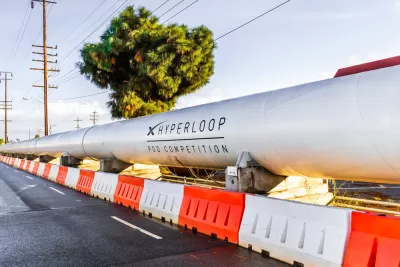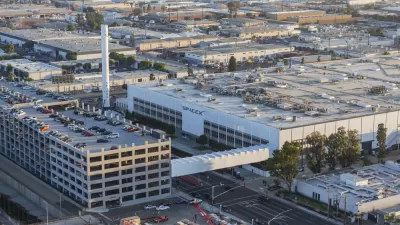After blocking sidewalk access for years, a tube segment in front of SpaceX’s Hawthorne office was removed at the city’s request, signaling a broader retreat from the project.

A tube that, for six years, hosted a variety of experimental transportation solutions that would theoretically have become Elon Musk’s Hyperloop has been removed from the right-of-way in front of SpaceX’s Hawthorne, California office.
As Jonah Valdez reports for the Los Angeles Times, the city received complaints about the tube, which residents claimed blocked pedestrian access. “The tube took up an eastbound lane heading toward Crenshaw Avenue, complicating existing concerns in the busy area about traffic congestion, drivers traveling at freeway speeds and pedestrian safety.” Multiple SpaceX employees were also hit by vehicles while crossing the street, prompting the company to build a pedestrian bridge to its parking garage.
While representatives for SpaceX and Boring Co. did not respond to inquiries, Bloomberg reported earlier this week that the Hyperloop “has been indefinitely shelved.” Local officials are unsure whether a mile-long underground test tunnel is still in use. Hawthorne City Attorney Robert Kim says the company is required to backfill the tunnel when testing is complete. “More recently, Musk backed out of a tunnel project that would have transported riders from the Rancho Cucamonga Metrolink station to Ontario International Airport. San Bernardino County transit officials plan to carry on the project without him.”
FULL STORY: Elon Musk's Hyperloop prototype tunnel removed in Hawthorne

Alabama: Trump Terminates Settlements for Black Communities Harmed By Raw Sewage
Trump deemed the landmark civil rights agreement “illegal DEI and environmental justice policy.”

Study: Maui’s Plan to Convert Vacation Rentals to Long-Term Housing Could Cause Nearly $1 Billion Economic Loss
The plan would reduce visitor accommodation by 25% resulting in 1,900 jobs lost.

Why Should We Subsidize Public Transportation?
Many public transit agencies face financial stress due to rising costs, declining fare revenue, and declining subsidies. Transit advocates must provide a strong business case for increasing public transit funding.

Paris Bike Boom Leads to Steep Drop in Air Pollution
The French city’s air quality has improved dramatically in the past 20 years, coinciding with a growth in cycling.

Why Housing Costs More to Build in California Than in Texas
Hard costs like labor and materials combined with ‘soft’ costs such as permitting make building in the San Francisco Bay Area almost three times as costly as in Texas cities.

San Diego County Sees a Rise in Urban Coyotes
San Diego County experiences a rise in urban coyotes, as sightings become prevalent throughout its urban neighbourhoods and surrounding areas.
Urban Design for Planners 1: Software Tools
This six-course series explores essential urban design concepts using open source software and equips planners with the tools they need to participate fully in the urban design process.
Planning for Universal Design
Learn the tools for implementing Universal Design in planning regulations.
Smith Gee Studio
Alamo Area Metropolitan Planning Organization
City of Santa Clarita
Institute for Housing and Urban Development Studies (IHS)
City of Grandview
Harvard GSD Executive Education
Toledo-Lucas County Plan Commissions
Salt Lake City
NYU Wagner Graduate School of Public Service




























